Brand Management Report: Morrison's Brand Strategy Analysis
VerifiedAdded on 2021/08/06
|24
|5846
|161
Report
AI Summary
This report provides a comprehensive analysis of brand management, using the UK grocery chain Morrison's as a case study. It begins by explaining the significance of branding as a marketing strategy and its prevalence in corporate practice, highlighting the importance of brand management in the retail industry for attracting customers, increasing profits, and enhancing brand value. The report then evaluates the critical elements of an effective brand strategy for managing and building brand equity, including brand loyalty, brand awareness, and brand associations, referencing models like Keller's Brand Equity Model and Aaker's Brand Equity Model. It further examines portfolio management, brand equity management, and brand hierarchy, as well as how brands manage collaborations and partnerships at both national and international levels. Finally, the report analyzes various techniques and methods for managing and measuring brand value, offering practical insights into assessing Morrison's brand value and overall marketing strategies. The report covers various aspects of brand management, from the importance of branding to the techniques used to measure brand value, providing a holistic view of brand management strategies.

BRAND
MANAGEMENT
1
MANAGEMENT
1
Paraphrase This Document
Need a fresh take? Get an instant paraphrase of this document with our AI Paraphraser
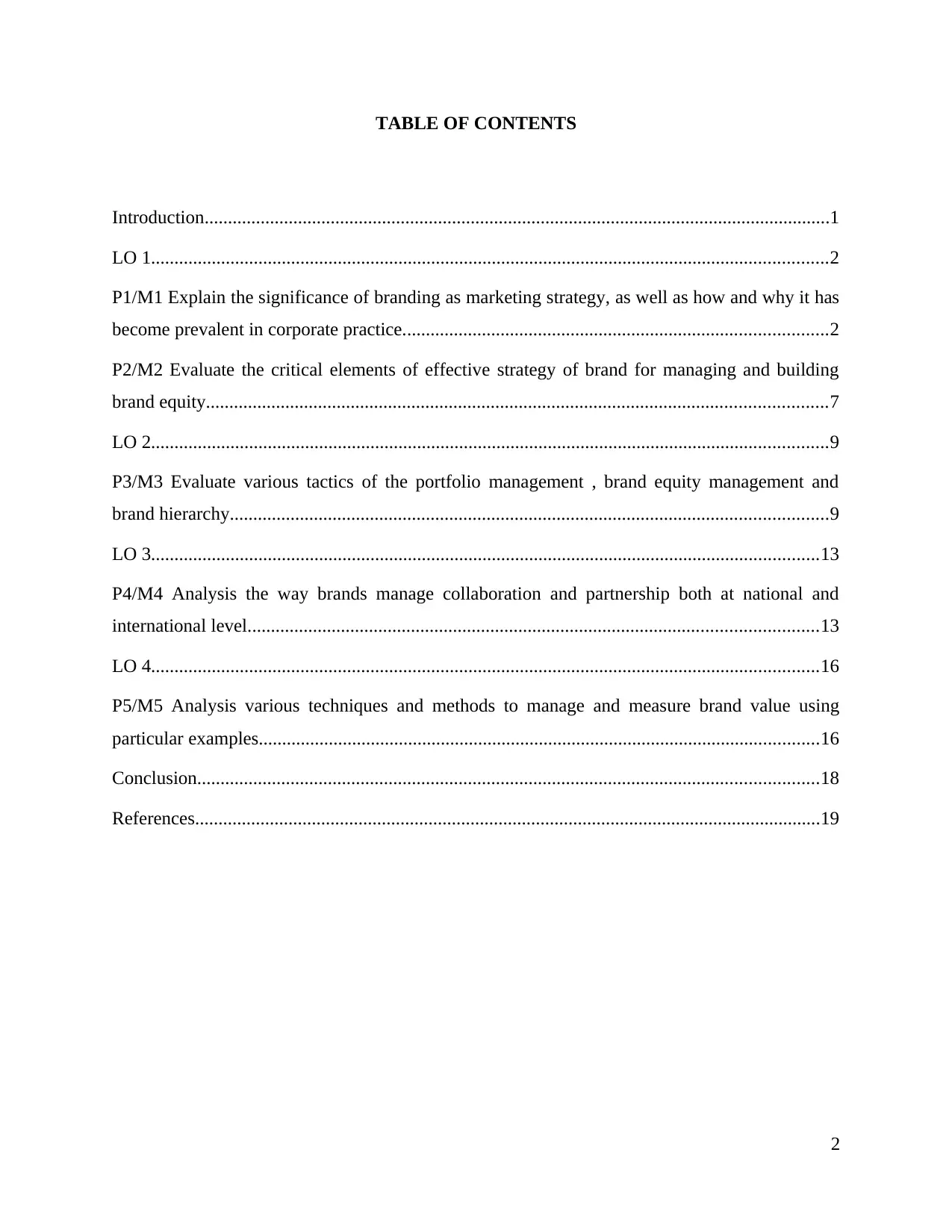
TABLE OF CONTENTS
Introduction......................................................................................................................................1
LO 1.................................................................................................................................................2
P1/M1 Explain the significance of branding as marketing strategy, as well as how and why it has
become prevalent in corporate practice...........................................................................................2
P2/M2 Evaluate the critical elements of effective strategy of brand for managing and building
brand equity.....................................................................................................................................7
LO 2.................................................................................................................................................9
P3/M3 Evaluate various tactics of the portfolio management , brand equity management and
brand hierarchy................................................................................................................................9
LO 3...............................................................................................................................................13
P4/M4 Analysis the way brands manage collaboration and partnership both at national and
international level..........................................................................................................................13
LO 4...............................................................................................................................................16
P5/M5 Analysis various techniques and methods to manage and measure brand value using
particular examples........................................................................................................................16
Conclusion.....................................................................................................................................18
References......................................................................................................................................19
2
Introduction......................................................................................................................................1
LO 1.................................................................................................................................................2
P1/M1 Explain the significance of branding as marketing strategy, as well as how and why it has
become prevalent in corporate practice...........................................................................................2
P2/M2 Evaluate the critical elements of effective strategy of brand for managing and building
brand equity.....................................................................................................................................7
LO 2.................................................................................................................................................9
P3/M3 Evaluate various tactics of the portfolio management , brand equity management and
brand hierarchy................................................................................................................................9
LO 3...............................................................................................................................................13
P4/M4 Analysis the way brands manage collaboration and partnership both at national and
international level..........................................................................................................................13
LO 4...............................................................................................................................................16
P5/M5 Analysis various techniques and methods to manage and measure brand value using
particular examples........................................................................................................................16
Conclusion.....................................................................................................................................18
References......................................................................................................................................19
2
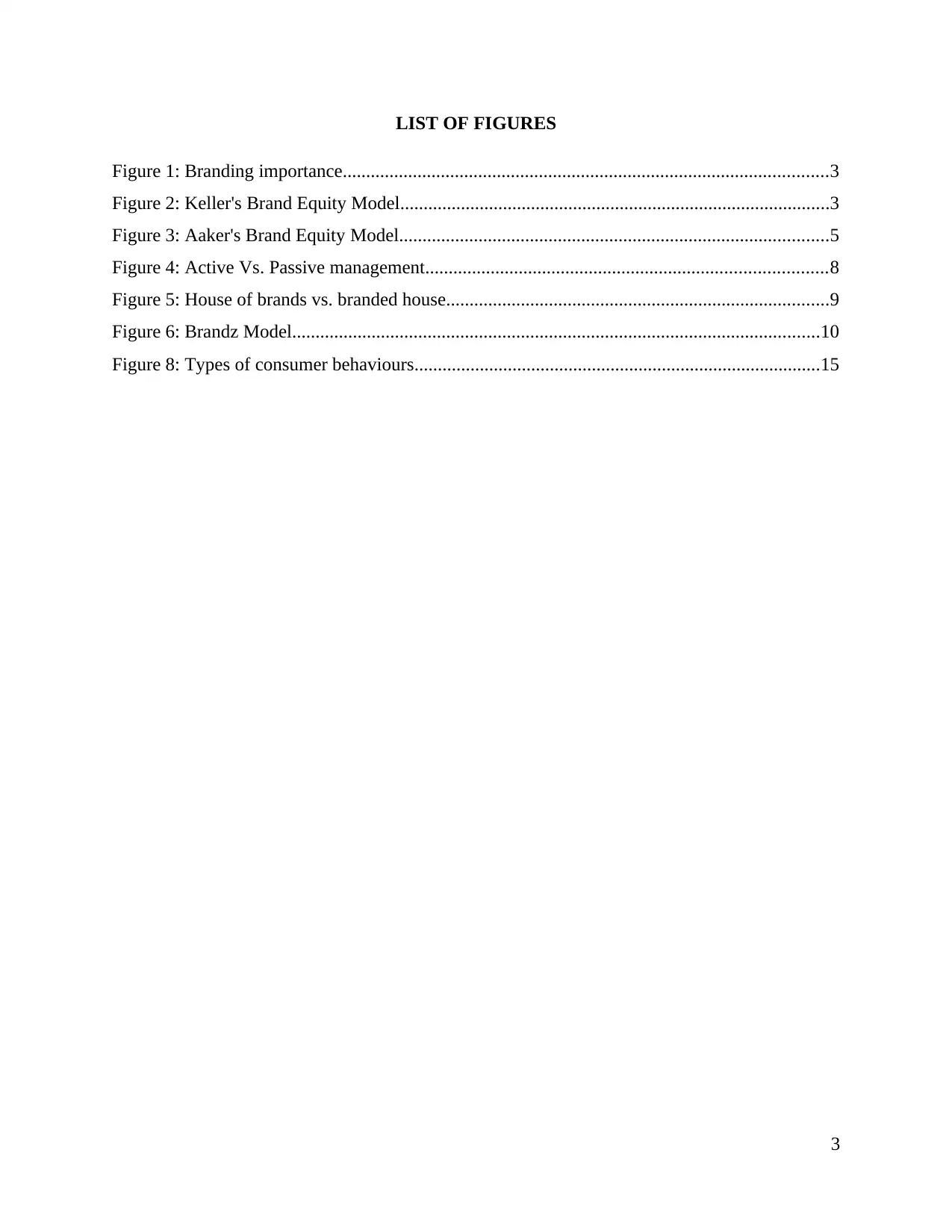
LIST OF FIGURES
Figure 1: Branding importance........................................................................................................3
Figure 2: Keller's Brand Equity Model............................................................................................3
Figure 3: Aaker's Brand Equity Model............................................................................................5
Figure 4: Active Vs. Passive management......................................................................................8
Figure 5: House of brands vs. branded house..................................................................................9
Figure 6: Brandz Model.................................................................................................................10
Figure 8: Types of consumer behaviours.......................................................................................15
3
Figure 1: Branding importance........................................................................................................3
Figure 2: Keller's Brand Equity Model............................................................................................3
Figure 3: Aaker's Brand Equity Model............................................................................................5
Figure 4: Active Vs. Passive management......................................................................................8
Figure 5: House of brands vs. branded house..................................................................................9
Figure 6: Brandz Model.................................................................................................................10
Figure 8: Types of consumer behaviours.......................................................................................15
3
⊘ This is a preview!⊘
Do you want full access?
Subscribe today to unlock all pages.

Trusted by 1+ million students worldwide
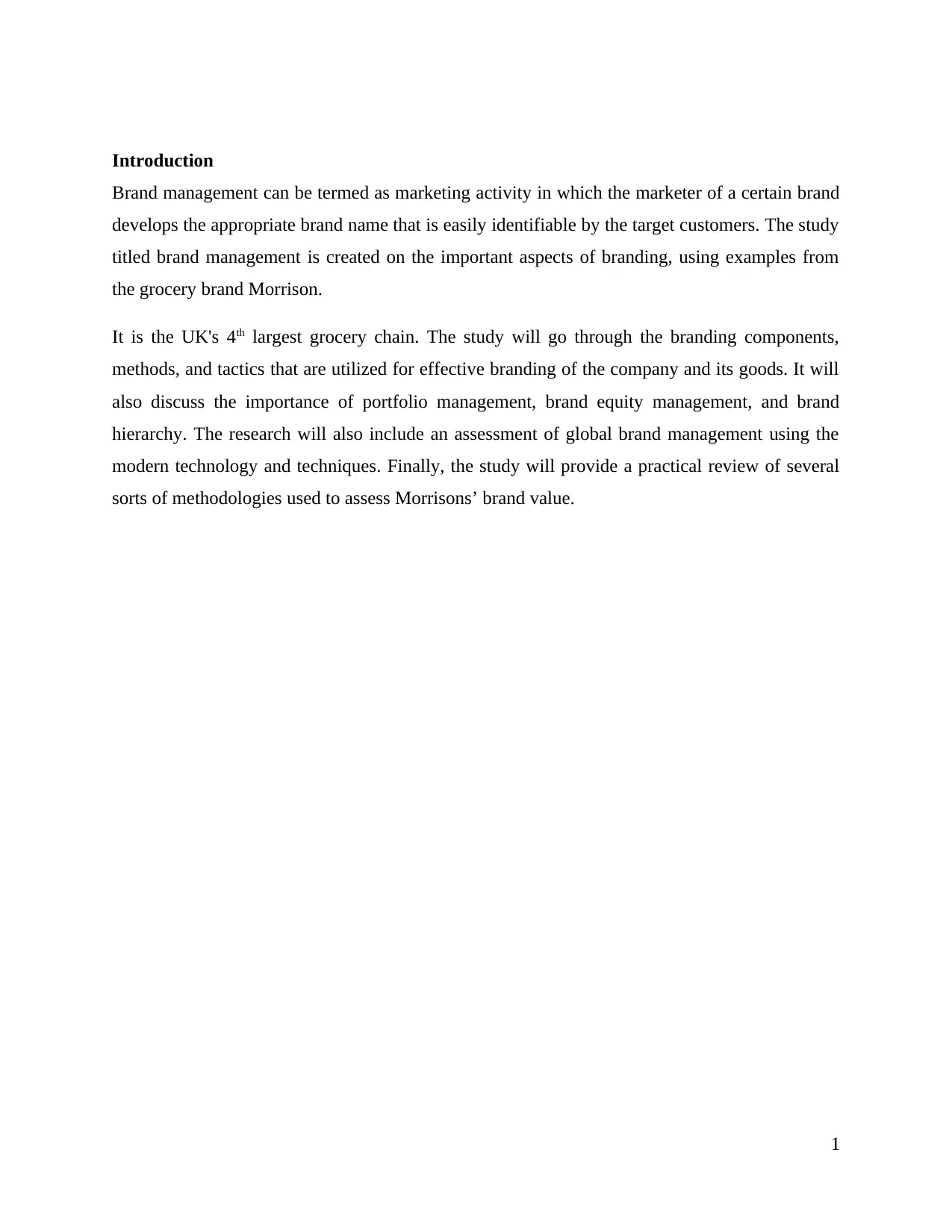
Introduction
Brand management can be termed as marketing activity in which the marketer of a certain brand
develops the appropriate brand name that is easily identifiable by the target customers. The study
titled brand management is created on the important aspects of branding, using examples from
the grocery brand Morrison.
It is the UK's 4th largest grocery chain. The study will go through the branding components,
methods, and tactics that are utilized for effective branding of the company and its goods. It will
also discuss the importance of portfolio management, brand equity management, and brand
hierarchy. The research will also include an assessment of global brand management using the
modern technology and techniques. Finally, the study will provide a practical review of several
sorts of methodologies used to assess Morrisons’ brand value.
1
Brand management can be termed as marketing activity in which the marketer of a certain brand
develops the appropriate brand name that is easily identifiable by the target customers. The study
titled brand management is created on the important aspects of branding, using examples from
the grocery brand Morrison.
It is the UK's 4th largest grocery chain. The study will go through the branding components,
methods, and tactics that are utilized for effective branding of the company and its goods. It will
also discuss the importance of portfolio management, brand equity management, and brand
hierarchy. The research will also include an assessment of global brand management using the
modern technology and techniques. Finally, the study will provide a practical review of several
sorts of methodologies used to assess Morrisons’ brand value.
1
Paraphrase This Document
Need a fresh take? Get an instant paraphrase of this document with our AI Paraphraser
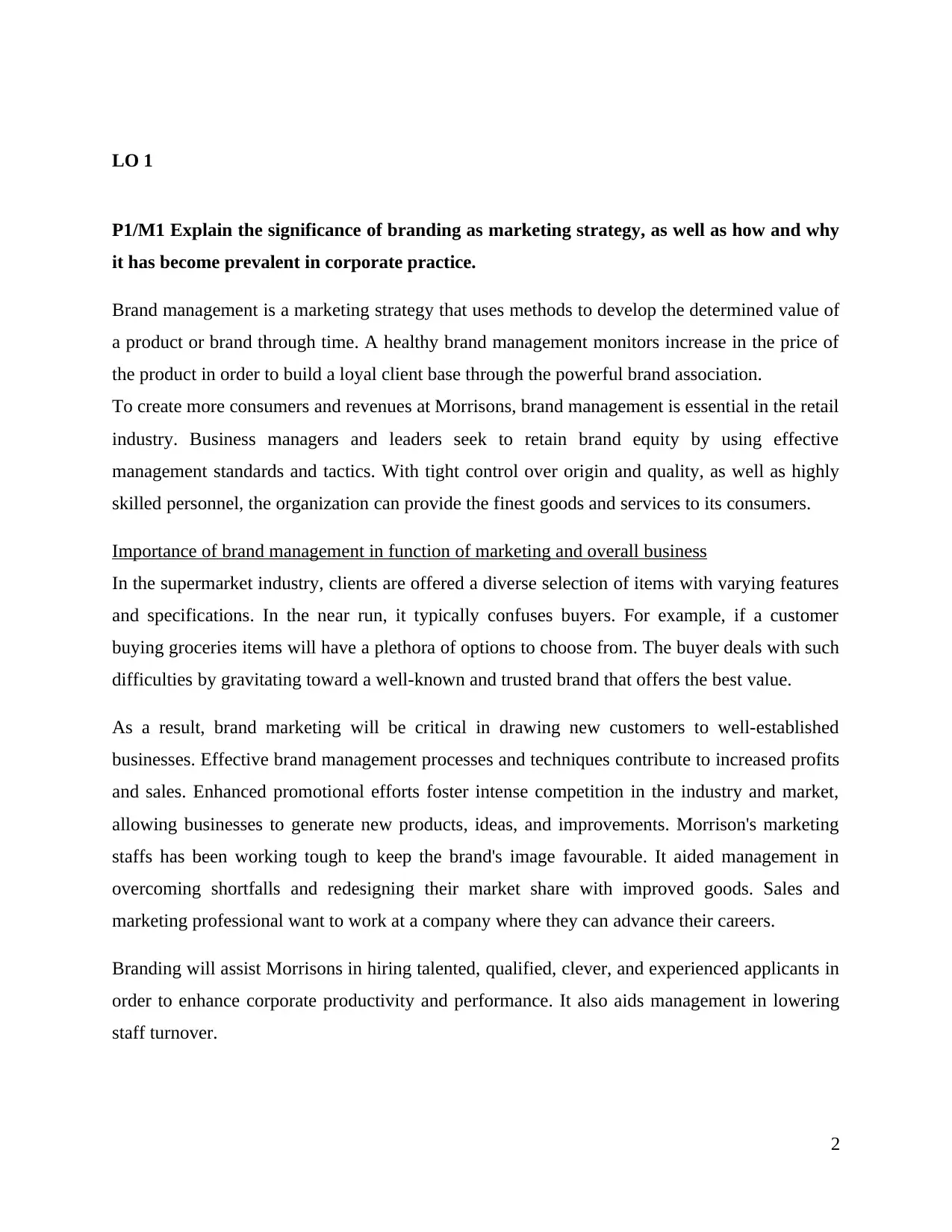
LO 1
P1/M1 Explain the significance of branding as marketing strategy, as well as how and why
it has become prevalent in corporate practice.
Brand management is a marketing strategy that uses methods to develop the determined value of
a product or brand through time. A healthy brand management monitors increase in the price of
the product in order to build a loyal client base through the powerful brand association.
To create more consumers and revenues at Morrisons, brand management is essential in the retail
industry. Business managers and leaders seek to retain brand equity by using effective
management standards and tactics. With tight control over origin and quality, as well as highly
skilled personnel, the organization can provide the finest goods and services to its consumers.
Importance of brand management in function of marketing and overall business
In the supermarket industry, clients are offered a diverse selection of items with varying features
and specifications. In the near run, it typically confuses buyers. For example, if a customer
buying groceries items will have a plethora of options to choose from. The buyer deals with such
difficulties by gravitating toward a well-known and trusted brand that offers the best value.
As a result, brand marketing will be critical in drawing new customers to well-established
businesses. Effective brand management processes and techniques contribute to increased profits
and sales. Enhanced promotional efforts foster intense competition in the industry and market,
allowing businesses to generate new products, ideas, and improvements. Morrison's marketing
staffs has been working tough to keep the brand's image favourable. It aided management in
overcoming shortfalls and redesigning their market share with improved goods. Sales and
marketing professional want to work at a company where they can advance their careers.
Branding will assist Morrisons in hiring talented, qualified, clever, and experienced applicants in
order to enhance corporate productivity and performance. It also aids management in lowering
staff turnover.
2
P1/M1 Explain the significance of branding as marketing strategy, as well as how and why
it has become prevalent in corporate practice.
Brand management is a marketing strategy that uses methods to develop the determined value of
a product or brand through time. A healthy brand management monitors increase in the price of
the product in order to build a loyal client base through the powerful brand association.
To create more consumers and revenues at Morrisons, brand management is essential in the retail
industry. Business managers and leaders seek to retain brand equity by using effective
management standards and tactics. With tight control over origin and quality, as well as highly
skilled personnel, the organization can provide the finest goods and services to its consumers.
Importance of brand management in function of marketing and overall business
In the supermarket industry, clients are offered a diverse selection of items with varying features
and specifications. In the near run, it typically confuses buyers. For example, if a customer
buying groceries items will have a plethora of options to choose from. The buyer deals with such
difficulties by gravitating toward a well-known and trusted brand that offers the best value.
As a result, brand marketing will be critical in drawing new customers to well-established
businesses. Effective brand management processes and techniques contribute to increased profits
and sales. Enhanced promotional efforts foster intense competition in the industry and market,
allowing businesses to generate new products, ideas, and improvements. Morrison's marketing
staffs has been working tough to keep the brand's image favourable. It aided management in
overcoming shortfalls and redesigning their market share with improved goods. Sales and
marketing professional want to work at a company where they can advance their careers.
Branding will assist Morrisons in hiring talented, qualified, clever, and experienced applicants in
order to enhance corporate productivity and performance. It also aids management in lowering
staff turnover.
2
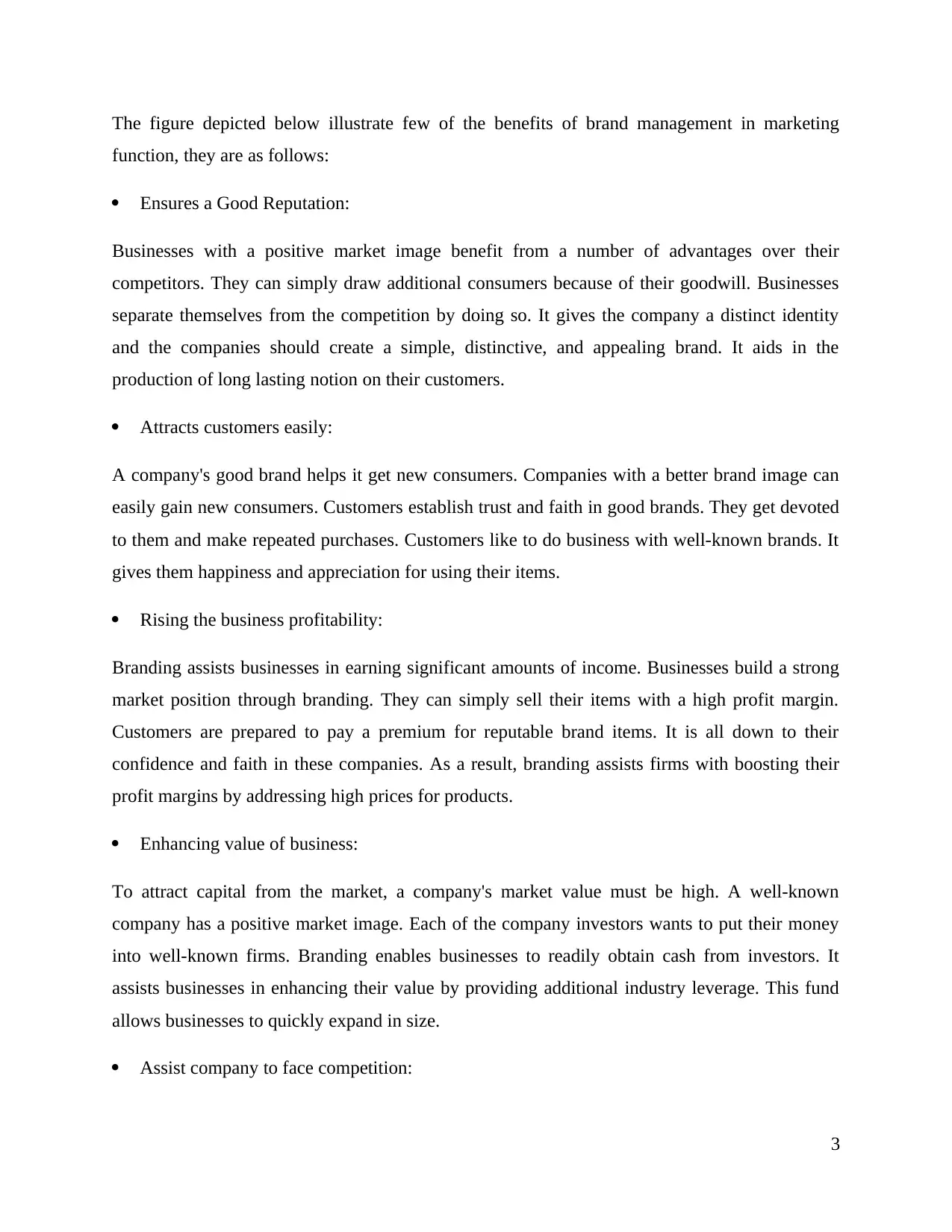
The figure depicted below illustrate few of the benefits of brand management in marketing
function, they are as follows:
Ensures a Good Reputation:
Businesses with a positive market image benefit from a number of advantages over their
competitors. They can simply draw additional consumers because of their goodwill. Businesses
separate themselves from the competition by doing so. It gives the company a distinct identity
and the companies should create a simple, distinctive, and appealing brand. It aids in the
production of long lasting notion on their customers.
Attracts customers easily:
A company's good brand helps it get new consumers. Companies with a better brand image can
easily gain new consumers. Customers establish trust and faith in good brands. They get devoted
to them and make repeated purchases. Customers like to do business with well-known brands. It
gives them happiness and appreciation for using their items.
Rising the business profitability:
Branding assists businesses in earning significant amounts of income. Businesses build a strong
market position through branding. They can simply sell their items with a high profit margin.
Customers are prepared to pay a premium for reputable brand items. It is all down to their
confidence and faith in these companies. As a result, branding assists firms with boosting their
profit margins by addressing high prices for products.
Enhancing value of business:
To attract capital from the market, a company's market value must be high. A well-known
company has a positive market image. Each of the company investors wants to put their money
into well-known firms. Branding enables businesses to readily obtain cash from investors. It
assists businesses in enhancing their value by providing additional industry leverage. This fund
allows businesses to quickly expand in size.
Assist company to face competition:
3
function, they are as follows:
Ensures a Good Reputation:
Businesses with a positive market image benefit from a number of advantages over their
competitors. They can simply draw additional consumers because of their goodwill. Businesses
separate themselves from the competition by doing so. It gives the company a distinct identity
and the companies should create a simple, distinctive, and appealing brand. It aids in the
production of long lasting notion on their customers.
Attracts customers easily:
A company's good brand helps it get new consumers. Companies with a better brand image can
easily gain new consumers. Customers establish trust and faith in good brands. They get devoted
to them and make repeated purchases. Customers like to do business with well-known brands. It
gives them happiness and appreciation for using their items.
Rising the business profitability:
Branding assists businesses in earning significant amounts of income. Businesses build a strong
market position through branding. They can simply sell their items with a high profit margin.
Customers are prepared to pay a premium for reputable brand items. It is all down to their
confidence and faith in these companies. As a result, branding assists firms with boosting their
profit margins by addressing high prices for products.
Enhancing value of business:
To attract capital from the market, a company's market value must be high. A well-known
company has a positive market image. Each of the company investors wants to put their money
into well-known firms. Branding enables businesses to readily obtain cash from investors. It
assists businesses in enhancing their value by providing additional industry leverage. This fund
allows businesses to quickly expand in size.
Assist company to face competition:
3
⊘ This is a preview!⊘
Do you want full access?
Subscribe today to unlock all pages.

Trusted by 1+ million students worldwide
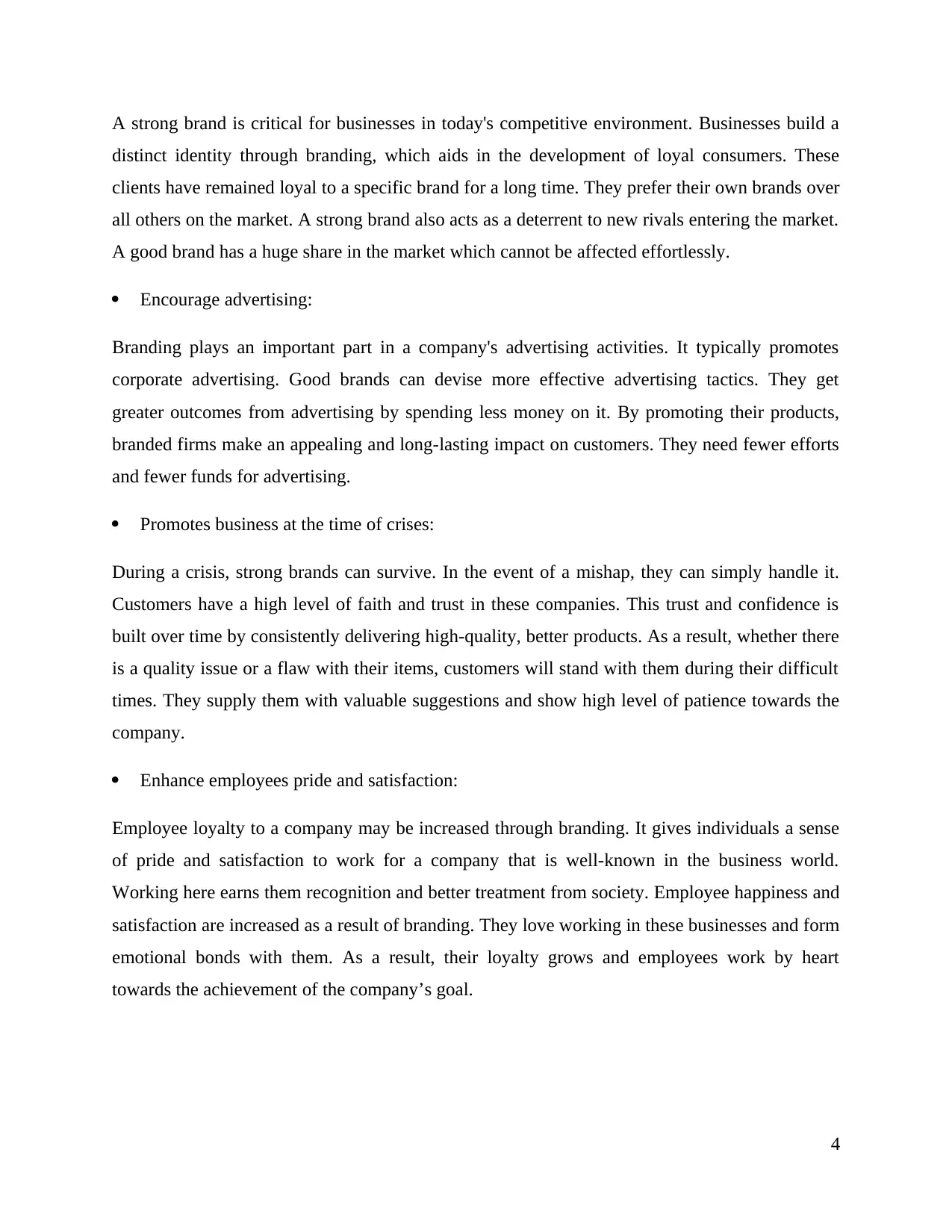
A strong brand is critical for businesses in today's competitive environment. Businesses build a
distinct identity through branding, which aids in the development of loyal consumers. These
clients have remained loyal to a specific brand for a long time. They prefer their own brands over
all others on the market. A strong brand also acts as a deterrent to new rivals entering the market.
A good brand has a huge share in the market which cannot be affected effortlessly.
Encourage advertising:
Branding plays an important part in a company's advertising activities. It typically promotes
corporate advertising. Good brands can devise more effective advertising tactics. They get
greater outcomes from advertising by spending less money on it. By promoting their products,
branded firms make an appealing and long-lasting impact on customers. They need fewer efforts
and fewer funds for advertising.
Promotes business at the time of crises:
During a crisis, strong brands can survive. In the event of a mishap, they can simply handle it.
Customers have a high level of faith and trust in these companies. This trust and confidence is
built over time by consistently delivering high-quality, better products. As a result, whether there
is a quality issue or a flaw with their items, customers will stand with them during their difficult
times. They supply them with valuable suggestions and show high level of patience towards the
company.
Enhance employees pride and satisfaction:
Employee loyalty to a company may be increased through branding. It gives individuals a sense
of pride and satisfaction to work for a company that is well-known in the business world.
Working here earns them recognition and better treatment from society. Employee happiness and
satisfaction are increased as a result of branding. They love working in these businesses and form
emotional bonds with them. As a result, their loyalty grows and employees work by heart
towards the achievement of the company’s goal.
4
distinct identity through branding, which aids in the development of loyal consumers. These
clients have remained loyal to a specific brand for a long time. They prefer their own brands over
all others on the market. A strong brand also acts as a deterrent to new rivals entering the market.
A good brand has a huge share in the market which cannot be affected effortlessly.
Encourage advertising:
Branding plays an important part in a company's advertising activities. It typically promotes
corporate advertising. Good brands can devise more effective advertising tactics. They get
greater outcomes from advertising by spending less money on it. By promoting their products,
branded firms make an appealing and long-lasting impact on customers. They need fewer efforts
and fewer funds for advertising.
Promotes business at the time of crises:
During a crisis, strong brands can survive. In the event of a mishap, they can simply handle it.
Customers have a high level of faith and trust in these companies. This trust and confidence is
built over time by consistently delivering high-quality, better products. As a result, whether there
is a quality issue or a flaw with their items, customers will stand with them during their difficult
times. They supply them with valuable suggestions and show high level of patience towards the
company.
Enhance employees pride and satisfaction:
Employee loyalty to a company may be increased through branding. It gives individuals a sense
of pride and satisfaction to work for a company that is well-known in the business world.
Working here earns them recognition and better treatment from society. Employee happiness and
satisfaction are increased as a result of branding. They love working in these businesses and form
emotional bonds with them. As a result, their loyalty grows and employees work by heart
towards the achievement of the company’s goal.
4
Paraphrase This Document
Need a fresh take? Get an instant paraphrase of this document with our AI Paraphraser
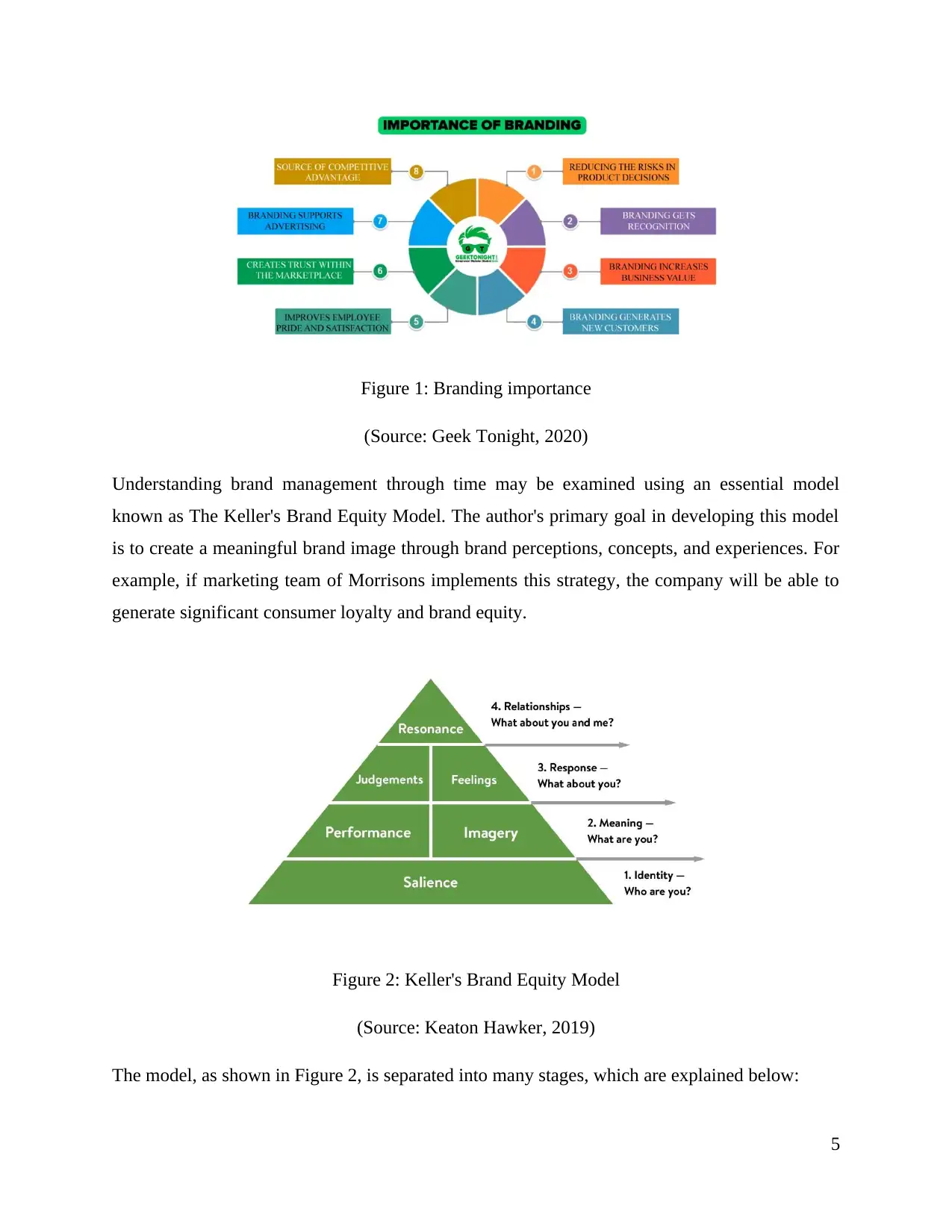
Figure 1: Branding importance
(Source: Geek Tonight, 2020)
Understanding brand management through time may be examined using an essential model
known as The Keller's Brand Equity Model. The author's primary goal in developing this model
is to create a meaningful brand image through brand perceptions, concepts, and experiences. For
example, if marketing team of Morrisons implements this strategy, the company will be able to
generate significant consumer loyalty and brand equity.
Figure 2: Keller's Brand Equity Model
(Source: Keaton Hawker, 2019)
The model, as shown in Figure 2, is separated into many stages, which are explained below:
5
(Source: Geek Tonight, 2020)
Understanding brand management through time may be examined using an essential model
known as The Keller's Brand Equity Model. The author's primary goal in developing this model
is to create a meaningful brand image through brand perceptions, concepts, and experiences. For
example, if marketing team of Morrisons implements this strategy, the company will be able to
generate significant consumer loyalty and brand equity.
Figure 2: Keller's Brand Equity Model
(Source: Keaton Hawker, 2019)
The model, as shown in Figure 2, is separated into many stages, which are explained below:
5
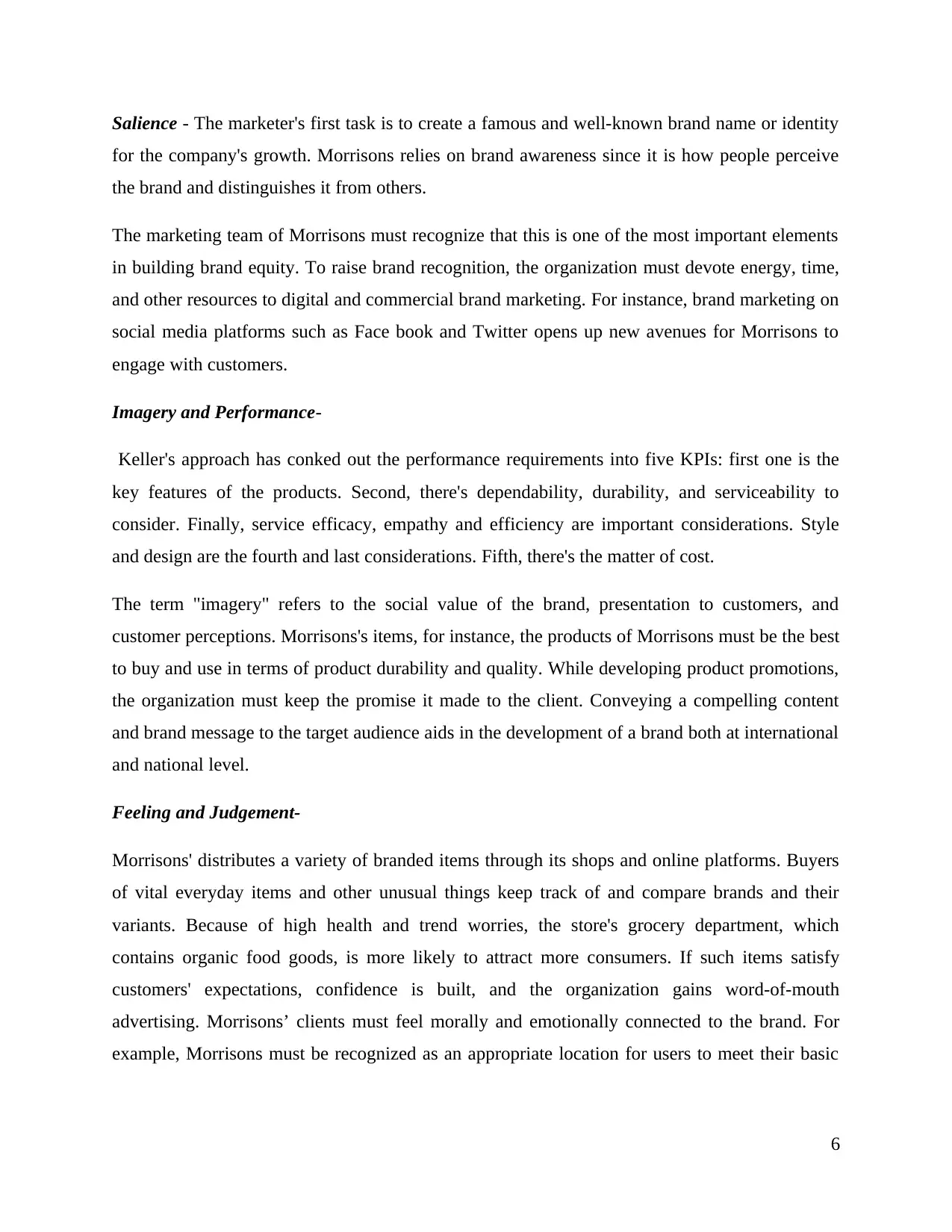
Salience - The marketer's first task is to create a famous and well-known brand name or identity
for the company's growth. Morrisons relies on brand awareness since it is how people perceive
the brand and distinguishes it from others.
The marketing team of Morrisons must recognize that this is one of the most important elements
in building brand equity. To raise brand recognition, the organization must devote energy, time,
and other resources to digital and commercial brand marketing. For instance, brand marketing on
social media platforms such as Face book and Twitter opens up new avenues for Morrisons to
engage with customers.
Imagery and Performance-
Keller's approach has conked out the performance requirements into five KPIs: first one is the
key features of the products. Second, there's dependability, durability, and serviceability to
consider. Finally, service efficacy, empathy and efficiency are important considerations. Style
and design are the fourth and last considerations. Fifth, there's the matter of cost.
The term "imagery" refers to the social value of the brand, presentation to customers, and
customer perceptions. Morrisons's items, for instance, the products of Morrisons must be the best
to buy and use in terms of product durability and quality. While developing product promotions,
the organization must keep the promise it made to the client. Conveying a compelling content
and brand message to the target audience aids in the development of a brand both at international
and national level.
Feeling and Judgement-
Morrisons' distributes a variety of branded items through its shops and online platforms. Buyers
of vital everyday items and other unusual things keep track of and compare brands and their
variants. Because of high health and trend worries, the store's grocery department, which
contains organic food goods, is more likely to attract more consumers. If such items satisfy
customers' expectations, confidence is built, and the organization gains word-of-mouth
advertising. Morrisons’ clients must feel morally and emotionally connected to the brand. For
example, Morrisons must be recognized as an appropriate location for users to meet their basic
6
for the company's growth. Morrisons relies on brand awareness since it is how people perceive
the brand and distinguishes it from others.
The marketing team of Morrisons must recognize that this is one of the most important elements
in building brand equity. To raise brand recognition, the organization must devote energy, time,
and other resources to digital and commercial brand marketing. For instance, brand marketing on
social media platforms such as Face book and Twitter opens up new avenues for Morrisons to
engage with customers.
Imagery and Performance-
Keller's approach has conked out the performance requirements into five KPIs: first one is the
key features of the products. Second, there's dependability, durability, and serviceability to
consider. Finally, service efficacy, empathy and efficiency are important considerations. Style
and design are the fourth and last considerations. Fifth, there's the matter of cost.
The term "imagery" refers to the social value of the brand, presentation to customers, and
customer perceptions. Morrisons's items, for instance, the products of Morrisons must be the best
to buy and use in terms of product durability and quality. While developing product promotions,
the organization must keep the promise it made to the client. Conveying a compelling content
and brand message to the target audience aids in the development of a brand both at international
and national level.
Feeling and Judgement-
Morrisons' distributes a variety of branded items through its shops and online platforms. Buyers
of vital everyday items and other unusual things keep track of and compare brands and their
variants. Because of high health and trend worries, the store's grocery department, which
contains organic food goods, is more likely to attract more consumers. If such items satisfy
customers' expectations, confidence is built, and the organization gains word-of-mouth
advertising. Morrisons’ clients must feel morally and emotionally connected to the brand. For
example, Morrisons must be recognized as an appropriate location for users to meet their basic
6
⊘ This is a preview!⊘
Do you want full access?
Subscribe today to unlock all pages.

Trusted by 1+ million students worldwide
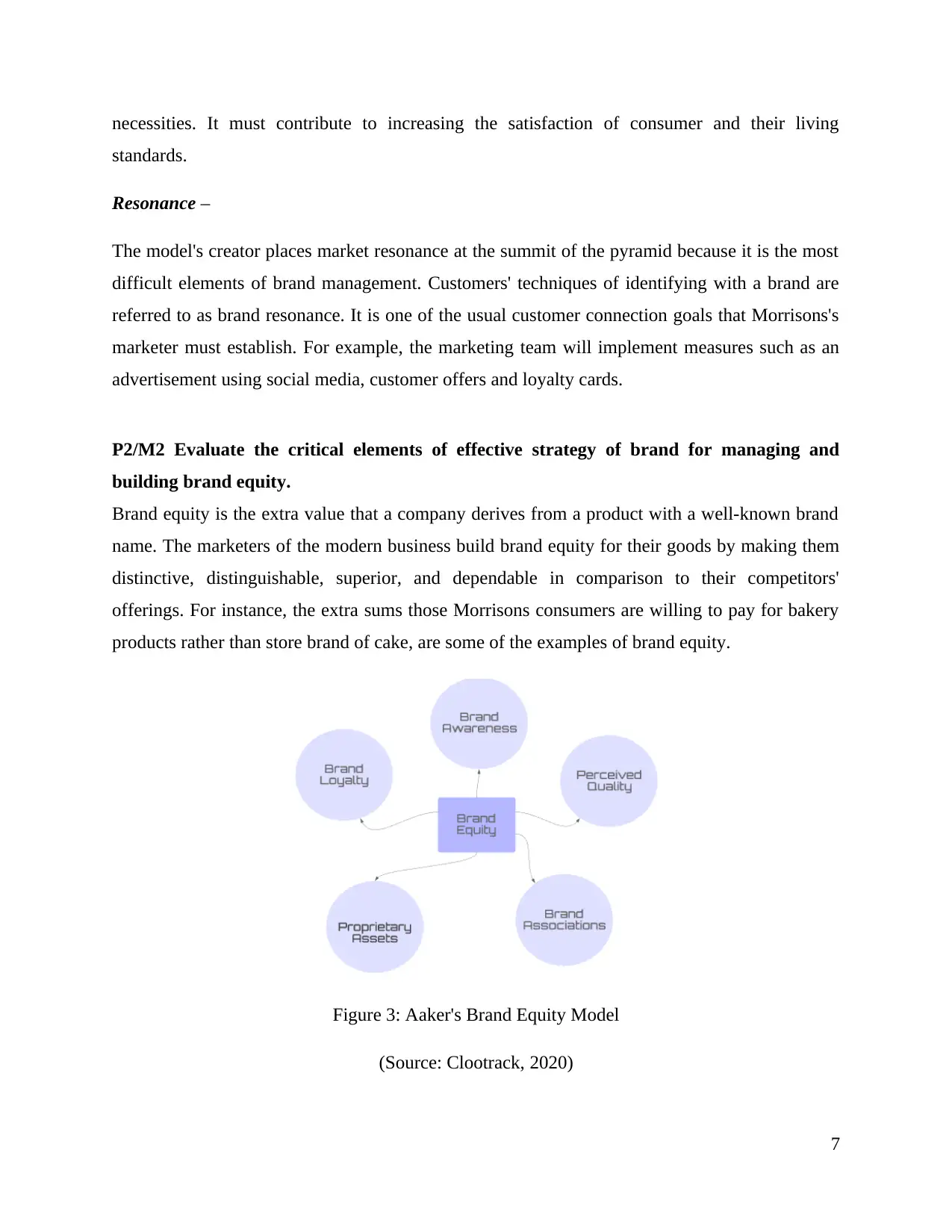
necessities. It must contribute to increasing the satisfaction of consumer and their living
standards.
Resonance –
The model's creator places market resonance at the summit of the pyramid because it is the most
difficult elements of brand management. Customers' techniques of identifying with a brand are
referred to as brand resonance. It is one of the usual customer connection goals that Morrisons's
marketer must establish. For example, the marketing team will implement measures such as an
advertisement using social media, customer offers and loyalty cards.
P2/M2 Evaluate the critical elements of effective strategy of brand for managing and
building brand equity.
Brand equity is the extra value that a company derives from a product with a well-known brand
name. The marketers of the modern business build brand equity for their goods by making them
distinctive, distinguishable, superior, and dependable in comparison to their competitors'
offerings. For instance, the extra sums those Morrisons consumers are willing to pay for bakery
products rather than store brand of cake, are some of the examples of brand equity.
Figure 3: Aaker's Brand Equity Model
(Source: Clootrack, 2020)
7
standards.
Resonance –
The model's creator places market resonance at the summit of the pyramid because it is the most
difficult elements of brand management. Customers' techniques of identifying with a brand are
referred to as brand resonance. It is one of the usual customer connection goals that Morrisons's
marketer must establish. For example, the marketing team will implement measures such as an
advertisement using social media, customer offers and loyalty cards.
P2/M2 Evaluate the critical elements of effective strategy of brand for managing and
building brand equity.
Brand equity is the extra value that a company derives from a product with a well-known brand
name. The marketers of the modern business build brand equity for their goods by making them
distinctive, distinguishable, superior, and dependable in comparison to their competitors'
offerings. For instance, the extra sums those Morrisons consumers are willing to pay for bakery
products rather than store brand of cake, are some of the examples of brand equity.
Figure 3: Aaker's Brand Equity Model
(Source: Clootrack, 2020)
7
Paraphrase This Document
Need a fresh take? Get an instant paraphrase of this document with our AI Paraphraser
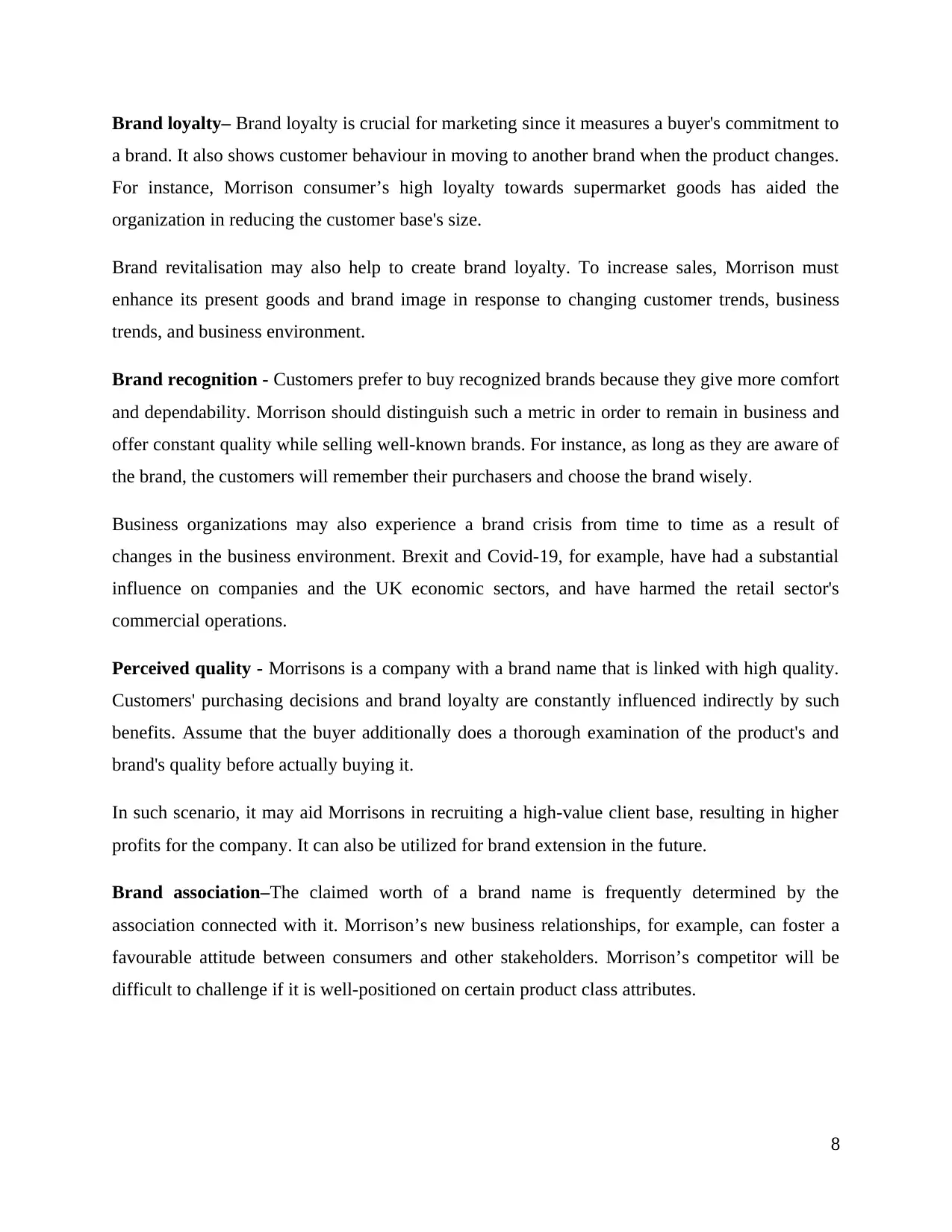
Brand loyalty– Brand loyalty is crucial for marketing since it measures a buyer's commitment to
a brand. It also shows customer behaviour in moving to another brand when the product changes.
For instance, Morrison consumer’s high loyalty towards supermarket goods has aided the
organization in reducing the customer base's size.
Brand revitalisation may also help to create brand loyalty. To increase sales, Morrison must
enhance its present goods and brand image in response to changing customer trends, business
trends, and business environment.
Brand recognition - Customers prefer to buy recognized brands because they give more comfort
and dependability. Morrison should distinguish such a metric in order to remain in business and
offer constant quality while selling well-known brands. For instance, as long as they are aware of
the brand, the customers will remember their purchasers and choose the brand wisely.
Business organizations may also experience a brand crisis from time to time as a result of
changes in the business environment. Brexit and Covid-19, for example, have had a substantial
influence on companies and the UK economic sectors, and have harmed the retail sector's
commercial operations.
Perceived quality - Morrisons is a company with a brand name that is linked with high quality.
Customers' purchasing decisions and brand loyalty are constantly influenced indirectly by such
benefits. Assume that the buyer additionally does a thorough examination of the product's and
brand's quality before actually buying it.
In such scenario, it may aid Morrisons in recruiting a high-value client base, resulting in higher
profits for the company. It can also be utilized for brand extension in the future.
Brand association–The claimed worth of a brand name is frequently determined by the
association connected with it. Morrison’s new business relationships, for example, can foster a
favourable attitude between consumers and other stakeholders. Morrison’s competitor will be
difficult to challenge if it is well-positioned on certain product class attributes.
8
a brand. It also shows customer behaviour in moving to another brand when the product changes.
For instance, Morrison consumer’s high loyalty towards supermarket goods has aided the
organization in reducing the customer base's size.
Brand revitalisation may also help to create brand loyalty. To increase sales, Morrison must
enhance its present goods and brand image in response to changing customer trends, business
trends, and business environment.
Brand recognition - Customers prefer to buy recognized brands because they give more comfort
and dependability. Morrison should distinguish such a metric in order to remain in business and
offer constant quality while selling well-known brands. For instance, as long as they are aware of
the brand, the customers will remember their purchasers and choose the brand wisely.
Business organizations may also experience a brand crisis from time to time as a result of
changes in the business environment. Brexit and Covid-19, for example, have had a substantial
influence on companies and the UK economic sectors, and have harmed the retail sector's
commercial operations.
Perceived quality - Morrisons is a company with a brand name that is linked with high quality.
Customers' purchasing decisions and brand loyalty are constantly influenced indirectly by such
benefits. Assume that the buyer additionally does a thorough examination of the product's and
brand's quality before actually buying it.
In such scenario, it may aid Morrisons in recruiting a high-value client base, resulting in higher
profits for the company. It can also be utilized for brand extension in the future.
Brand association–The claimed worth of a brand name is frequently determined by the
association connected with it. Morrison’s new business relationships, for example, can foster a
favourable attitude between consumers and other stakeholders. Morrison’s competitor will be
difficult to challenge if it is well-positioned on certain product class attributes.
8
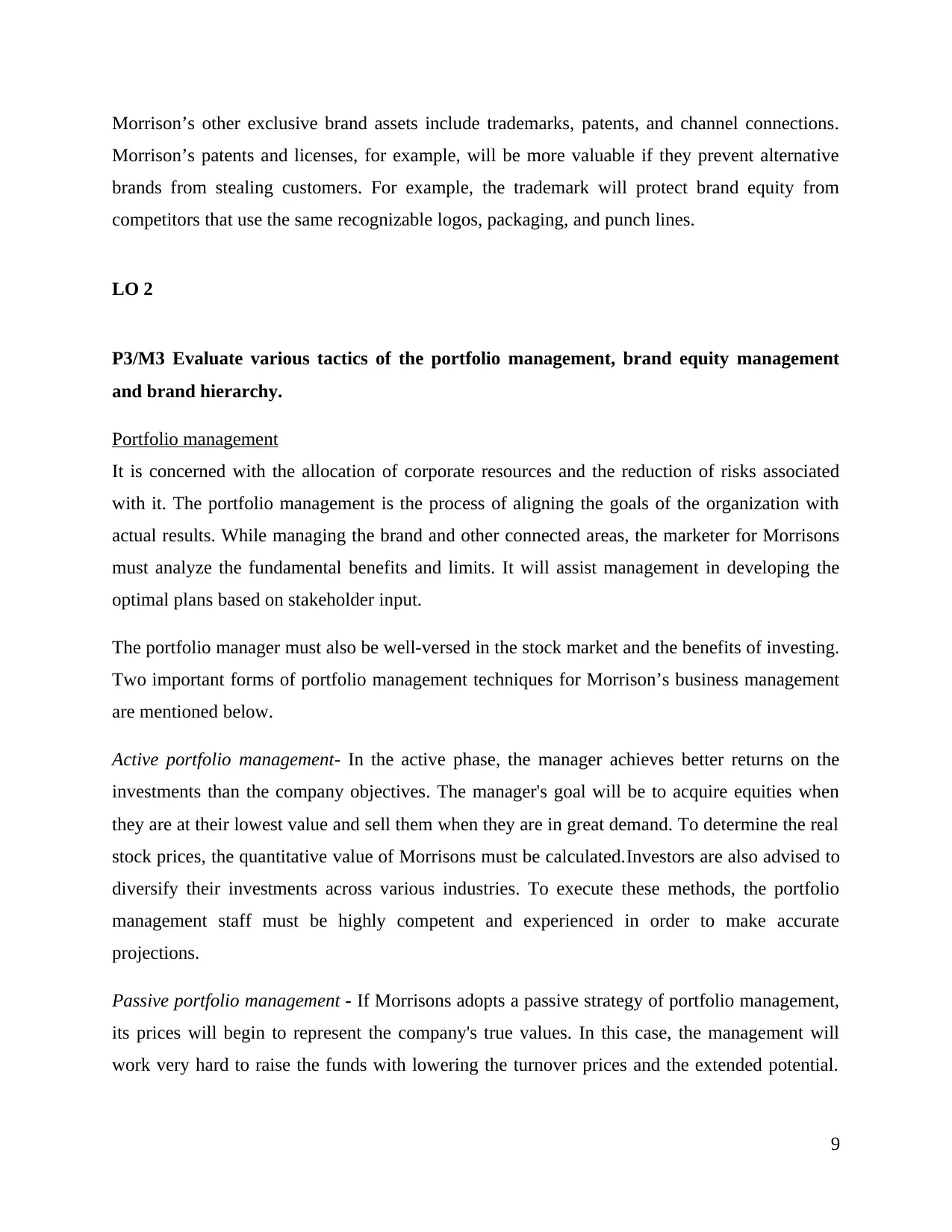
Morrison’s other exclusive brand assets include trademarks, patents, and channel connections.
Morrison’s patents and licenses, for example, will be more valuable if they prevent alternative
brands from stealing customers. For example, the trademark will protect brand equity from
competitors that use the same recognizable logos, packaging, and punch lines.
LO 2
P3/M3 Evaluate various tactics of the portfolio management, brand equity management
and brand hierarchy.
Portfolio management
It is concerned with the allocation of corporate resources and the reduction of risks associated
with it. The portfolio management is the process of aligning the goals of the organization with
actual results. While managing the brand and other connected areas, the marketer for Morrisons
must analyze the fundamental benefits and limits. It will assist management in developing the
optimal plans based on stakeholder input.
The portfolio manager must also be well-versed in the stock market and the benefits of investing.
Two important forms of portfolio management techniques for Morrison’s business management
are mentioned below.
Active portfolio management- In the active phase, the manager achieves better returns on the
investments than the company objectives. The manager's goal will be to acquire equities when
they are at their lowest value and sell them when they are in great demand. To determine the real
stock prices, the quantitative value of Morrisons must be calculated.Investors are also advised to
diversify their investments across various industries. To execute these methods, the portfolio
management staff must be highly competent and experienced in order to make accurate
projections.
Passive portfolio management - If Morrisons adopts a passive strategy of portfolio management,
its prices will begin to represent the company's true values. In this case, the management will
work very hard to raise the funds with lowering the turnover prices and the extended potential.
9
Morrison’s patents and licenses, for example, will be more valuable if they prevent alternative
brands from stealing customers. For example, the trademark will protect brand equity from
competitors that use the same recognizable logos, packaging, and punch lines.
LO 2
P3/M3 Evaluate various tactics of the portfolio management, brand equity management
and brand hierarchy.
Portfolio management
It is concerned with the allocation of corporate resources and the reduction of risks associated
with it. The portfolio management is the process of aligning the goals of the organization with
actual results. While managing the brand and other connected areas, the marketer for Morrisons
must analyze the fundamental benefits and limits. It will assist management in developing the
optimal plans based on stakeholder input.
The portfolio manager must also be well-versed in the stock market and the benefits of investing.
Two important forms of portfolio management techniques for Morrison’s business management
are mentioned below.
Active portfolio management- In the active phase, the manager achieves better returns on the
investments than the company objectives. The manager's goal will be to acquire equities when
they are at their lowest value and sell them when they are in great demand. To determine the real
stock prices, the quantitative value of Morrisons must be calculated.Investors are also advised to
diversify their investments across various industries. To execute these methods, the portfolio
management staff must be highly competent and experienced in order to make accurate
projections.
Passive portfolio management - If Morrisons adopts a passive strategy of portfolio management,
its prices will begin to represent the company's true values. In this case, the management will
work very hard to raise the funds with lowering the turnover prices and the extended potential.
9
⊘ This is a preview!⊘
Do you want full access?
Subscribe today to unlock all pages.

Trusted by 1+ million students worldwide
1 out of 24
Related Documents
Your All-in-One AI-Powered Toolkit for Academic Success.
+13062052269
info@desklib.com
Available 24*7 on WhatsApp / Email
![[object Object]](/_next/static/media/star-bottom.7253800d.svg)
Unlock your academic potential
Copyright © 2020–2025 A2Z Services. All Rights Reserved. Developed and managed by ZUCOL.


